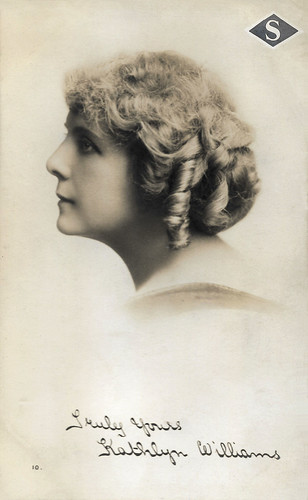
American postcard. Photo: Selig Polyscope Co.

American postcard by Kline Poster Co. Philadelphia. Image: V.L.S.E. V.L.S.E. was a distribution unit of the early film companies Vitagraph Lubin, Selig, and Essanay, led by distributor George Kleine. The company was founded in, but also already dissolved in 1916 when Vitagraph got a controlling interest in the other three companies.
Assorted jungle adventures and Westerns opposite Tom Mix
Kathlyn Williams was born Kathleen Mabel Williams, in 1879 in Butte, Montana. Williams began her career on stage in her hometown, where she was sponsored by local copper magnate William A. Clark to study acting in New York City.
In 1908 Williams began her film career at the Selig Polyscope Company in Chicago, Illinois and she made her first film under the direction of Francis Boggs: On Thanksgiving Day (Francis Boggs, 1908) with Hobart Bosworth.
However, according to Mark Garrett Cooper at Women Film Pioneers Project, Williams began "with Biograph in New York. 'I was playing in stock,' she recounted to Photoplay in 1917. 'One week when I was not working someone called me up from the Biograph studio and asked if I would work two days for them. I was dreadfully insulted at first, but I went out of curiosity expecting to be offered about fifty cents a day.' To her amazement, D. W. Griffith paid her ten dollars for each day’s work. Williams told Photoplay that she performed in three Biograph titles, but in combination, Paul Spehr and the American Film Institute catalog credit her with a total of five, with release dates beginning in 1909. "
By 1910, she was transferred to Selig's Los Angeles film studio. She became a popular star at Selig, where she was at first publicised as "The Selig Girl". She appeared in assorted jungle adventures for the studio as well as a number of Westerns opposite cowboy star Tom Mix.
She made history, however, with the very first serial adventure, The Adventures of Kathlyn (Francis J. Grandon, 1913). The film contained a number of wild animals, and it saved the faltering studio from bankruptcy. This serial was but one in a number of melodramas and jungle adventures teaming the actress with the Selig Polyscope Company's famous stable of wild animals. It was the nucleus for what would later become the Los Angeles Zoo.
Williams proceeded to remain a popular item after being handed the lead in the Selig epic The Spoilers (Colin Campbell, 1914), based upon Rex Beach's 1906 novel. Williams played her signature role of Cherry Marlotte, opposite William Farnum and Tom Santschi.

British postcard in the Selig Player Series, no. 10. Caption: Your favourite Film Artistes.

British postcard in the Selig Player Series. Caption: Your favourite Film Artistes.
Kathlyn's fair, spunky, coquettish looks grew suddenly grim and matronly
Once the Selig Studio folded, Kathlyn Williams signed with Paramount Pictures following her marriage to Paramount executive Charles F. Eyton in 1916. Eyton was a former actor, who later became the studio's General Manager.
At Paramount, she appeared as the star of several early dramas for both Cecil B. DeMille and his brother William C. de Mille. These films included The Whispering Chorus (1918), We Can't Have Everything (1918), The Tree of Knowledge (1920), and Conrad in Quest of His Youth (1920).
Her numerous co-stars included veteran matinée idols like Thomas Meighan, Theodore Roberts, and Tyrone Power Sr.), bit also young established stars as Wallace Reid, and Western heroes like Roy Stewart.
Kathlyn's fair, spunky, coquettish looks grew suddenly grim and matronly by the early 1920s and she moved swiftly into stately dramatic efforts, backing up such celebrity femmes of the day as May McAvoy, Betty Compson, Anita Page, Greta Garbo and even Joan Crawford before the advent of sound.
She retired from films in 1935 after only a handful of talkies and, though comebacks were bantered about from time to time in the gossip mill, nothing came of it. A tragic car accident in 1949 resulted in the loss of a leg, ending any chances whatsoever of revitalising her career. She was confined to a wheelchair for the remainder of her life.
Kathlyn Williams married and divorced three times. Her only child was Victor Hugo Kainer, from her first marriage to import/export businessman Otto Kainer. He was born in 1905 but died as a young teenager after developing influenza and succumbing to septic poisoning in 1922. After a brief marriage to actor Frank R. Allen, she married Charles Eyton. That marriage ended in 1931. Due to the loss of her leg, Kathlyn became a wheelchair-bound invalid in the last decade of her life. She succumbed to a massive heart attack in her Hollywood apartment in 1960, at age 81.
The Desmet Collection at EYE Filmmuseum in Amsterdam holds Kathlyn Williams' adventure films Captain Kate (1911), The Rose of Old St. Augustine (1911), and Lost in the Jungle, all by Otis Turner. EYE also holds fragments of The Adventures of Kathlyn. The Desmet films can be found online now at EYE's Desmet Playlist on YouTube.

Spanish collectors card.

British postcard in the Novelty Series, no. D6-7. Photo: Selig.
Sources: Gary Brumburgh (IMDb), Mark Garrett Cooper (Women Film Pioneers Project), Wikipedia, and IMDb.
No comments:
Post a Comment